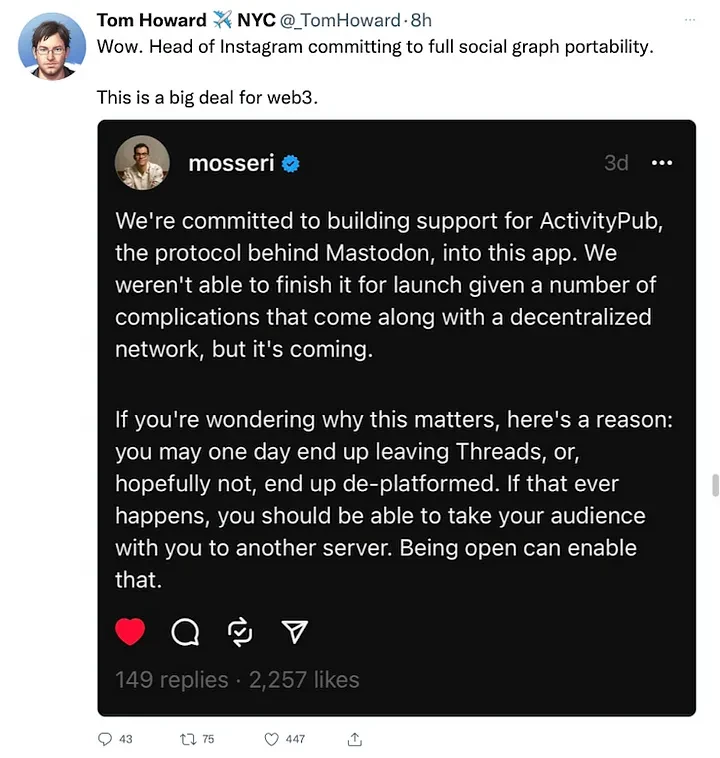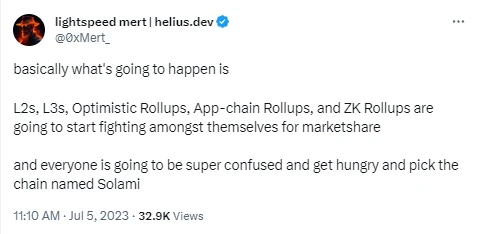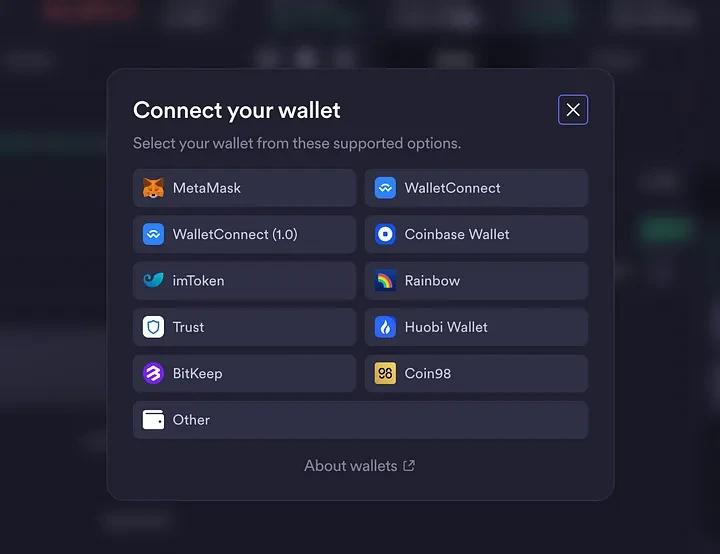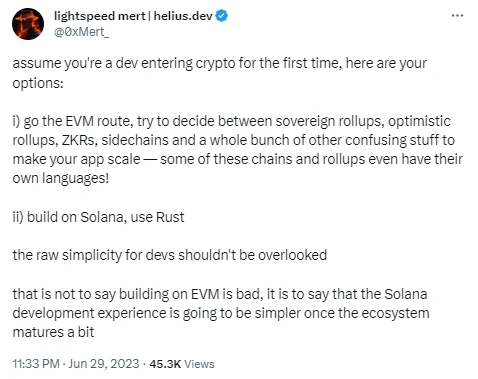Original author: Ann
Original translation: Baze Research Institute
The crypto community has been strange in the past few days, with Ethereum maximalists showing a sense of righteousness that borders on self-righteousness, rivaling that of Bitcoin maximalists when it comes to being annoying.
I understand. This situation started with the Multichain vulnerability and unfortunately, it has had the biggest impact on the Fantom blockchain. I don't understand why this would make Ethereum maxis feel superior to others because similar vulnerabilities could also occur on Ethereum.
Saying goodbye to Web 3 social
Yes, Zuckerberg is carving up this big cake of social media.
But what does this actually mean? How does "Twitter competitor" Threads, launched by Meta CEO Mark Zuckerberg, impact the cryptocurrency industry (especially Ethereum)? Will it have a more pronounced effect than Elon Musk's influence on Twitter?
The real victims aren't Twitter, but Lens Protocol - the advocates of our Web 3 social media future.
I have been following the development of Lens. It's been more than a year since it was launched, but frustratingly, they still restrict their service to invitees only, controlling access.
Musk has messed up Twitter several times, and competitors have taken advantage. First it was Mastodon, Nostr, and now Threads. Opportunities come and go, but Lens Protocol has missed out every time. This time is no exception.
To make matters worse, Meta plans to make Threads the way crypto enthusiasts envisioned: where you can move your profile and data to any other service or platform.

If Meta can really solve this problem, then we can bid farewell to the sluggish Lens Protocol once and for all.
Regarding why the development of Lens is not as fast as we hoped, I have a theory that I will discuss in this article.
dYdX Launches Cosmos-based Application Chain
Recently, dYdX finally released the v 4 testnet of its Cosmos-based application chain. It happens to be the timing when some Ethereum maximalists criticized Cosmos, saying that it lacks any useful applications.
These people easily forget a fact, which is that dYdX's decision to transition from the L 2 solution StarkWare to Cosmos was considered one of the biggest counteractions against Ethereum. What's wrong with Ethereum that even mature protocols like dYdX decided to go their own way?
The reason why dYdX chose to abandon the L 2 solution is the same as why you shouldn't bet 100% on Ethereum.
Ironically, for other L 1s, one of Ethereum's biggest problems is that it focuses too much on infrastructure (do we need more new dApps that crash and dramatically increase gas fees when the Ethereum mainnet is congested?). Therefore, Ethereum has not actually built many meaningful things for massive adoption (gas fees are still high).
Some people believe that consumer-oriented applications will be built on L 2 or rollups, but the latter are mostly still under ongoing development.
So it can be said with certainty that if we consider the cryptocurrency industry as a whole, any development geared towards massive adoption has been stagnant. Ethereum seems to have built many new dApps, but if you look closely, they may just be new derivative platforms, NFTs, etc. - many of which are not the kind of applications we really need for massive adoption.
"The smart contract platform with the most number of dApps" may be a sufficient reason in some cases, but it certainly cannot be used as an argument by Ethereum maximalists to belittle their competitors.
Ethereum may be the best choice for investment or application development at the moment. It is relatively stable to a certain extent because it is a native asset (with no bridging risks), has a high staking rate (stable liquidity), and also provides decent returns for stakers. Staking is currently at its historical high, and the new narrative of "re-staking" is gathering momentum.
But is it really wise to bet 100% on Ethereum?
Simplifying Complexity - User Experience is the Key to Mass Adoption

In DeFi user experience, "simplicity" is always preferred, especially from the perspective of Web 2 users and non-developers. Users must face the inefficiency of dispersing ETH into various L 2 solutions, just to save on gas fees.
We often think from the perspective of experienced DeFi users, and personally, I have fallen into this bias myself. As a DeFi veteran, I completely forgot that I once complained about the complexity of using Ethereum. As a crypto researcher, exploring various blockchain ecosystems is my job, and mild discomfort is not important to me.
But most people - the potential new users that the crypto industry is trying to attract - are not like that. Complexity remains a huge barrier.
Deploying dApps on a large L 1 chain or just floating around in an Ethereum L 2 can save a lot of trouble. Users of DeFi, SocialFi, GameFi, and NFT projects can seamlessly and cost-effectively experience them through "single-deposit." No need to bridge to other chains.
Developer Access Threshold is More Important
We can say that one day, when the user experience becomes smoother, people won't be able to tell if they are using L 1 or L 2, L 3 or Rollup, and concerns about the above points will become outdated.
For example, dYdX V 4 does a great job in supporting ETH wallets, even though it is based on the Cosmos protocol.

At the same time, the seamlessness of user experience is also the goal of account abstraction. With some cryptographic techniques, wallets will manage everything for users. Deposit once, and you can do anything anywhere without worrying about what happens behind the scenes (on-chain).
However, I think there is still a certain level of difficulty in implementing account abstraction wallets. Similar to creating a button for the frontend of a traditional application, it is not simple at all. Developers must build wallets that work for various ecosystems (different languages, tools, and standards) they intend to support.
For example, Starkware uses a programming language called Cairo, while if you're building based on privacy-centric Aztec, you must use Noir. Some developers have started advocating for using Rust to provide more secure code.
For an industry with only one-third of the total developer population for Meta employees, this is especially frustrating.
Although EVM-compatible solutions such as Optimism, Arbitrum, or zkSync may position themselves as "if a dApp can be built on Ethereum, it can also be directly plugged into L 2 at a cost that is only a small fraction of Ethereum" or "deployable with minimal code changes," more complex workflows may further distance you from reliability.

The choice between L 1 and L 2 is also confusing. What is your reason for choosing one blockchain over another if you are building a dApp? With the rapid progress of blockchain technology and the continuous development of market demand, which blockchain is not only the best at present but also future-oriented?
This decision is very important.
Now let's talk about Lens Protocol again.
I have my own hypothesis about why they always missed being a competitor to Twitter. It's because they are built on Polygon. I don't know their reasons (besides having Polygon Ventures as a venture capital), but it turns out to be a bad choice.
As we all know, Polygon is slow. I don't think it is capable of supporting social media applications with millions of potential users. Furthermore, it is planning to upgrade to Polygon 2.0, which puts existing dApps built on it in an uncertain state. Will they be able to migrate seamlessly? Is it still worth staying on Polygon when there are better blockchains?
Building a dApp in the rapidly iterating crypto industry itself is a risky business because one wrong move can result in real financial loss.
Developers need to choose the best construction site. Serious developers with strict technical requirements often end up choosing the Ethereum mainnet. Especially when they know their target market is DeFi whales. This is what happened with Blur (a professional NFT trading platform) and the recently launched EigenLayer. There's a reason why any hyped project ends up on the Ethereum mainnet. I wouldn't say it's "innovative," more like "innovative in closed loops," because very few users have the ability to play regularly on the Ethereum mainnet. We cannot just cater to the whales' needs.
Conclusion
The complexity itself is enough reason to seek alternative solutions, as dYdX's departure from Ethereum L 2 clearly demonstrates. After all, it is wise to "not put all your eggs in one basket".
Whether you are an investor or a developer, if you are still hesitant, rest assured that even the most fervent Ethereum supporters secretly fund other L 1 solutions, as I have mentioned in my previous articles (hinting at Ethereum maximalist Cobie's investment in the new L 1 Monad this year). I bet there are quite a few people like that.
Disclaimer:
According to the notice issued by the central bank and other departments on "Further Preventing and Dealing with Speculative Risks in Virtual Currency Trading", the content of this article is for informational purposes only and does not endorse or promote any business or investment activities. Readers are strictly advised to comply with local laws and regulations and refrain from participating in any illegal financial activities.










